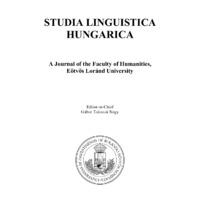Elemkészletek
Cím
eng
Noun durations with and without suffixes across ages
Szerző
Folyóiratszám
Kiadó
Eötvös Loránd University, Faculty of Humanities See all Elemek with this value
Kiadás éve
2020
Kiadás helye
Kezdőoldal
17
Utolsó oldal
27
Nyelv
Azonosító
Tárgyszó
eng
monomorphemic and multimorphemic nouns
eng
temporal patterns
eng
children’s word production
eng
lexical route
Dokumentumtípus (Getty AAT)
Tudományterület (Getty AAT)
Absztrakt
eng
Temporal properties of words are defined by several physiological, psychical, and language-specific factors that interact with each other in spontaneous speech. Storage of lexical representations either in a morphologically decomposed form or in a conceptually non-decomposed form is supposed to influ-ence word durations, particularly during language acquisition. To access the appropriate suffix and combination of stem and suffix requires greater mental effort from children than from adults. The pro-cess is assumed to result in longer word durations. The goal of the present study is to analyse the possiblechanges in word durations depending on the morphological structure of words across ages. We assumedthat the duration of words with and without suffixes would show age-specific differences.
Hungarian nouns with various lengths (containing 2, 3 and 4 syllables with and without suffixes) produced by 30 children (ages of 5, 7 and 9) and 10 young adults in spontaneous utterances were measured. Word durations revealed significant differences depending on age and on the words’ mor-phological structures. Monomorphemic nouns were shorter than multimorphemic nouns of the same length in all experimental groups. Durational differences between monomorphemic and multimor-phemic nouns, however, showed gradualchanges according to age, being larger in younger children and smaller in older children and adults.
Our interpretation is that the longer route of lexical access for multimorphemic words in young children can be explained by their developing routine for accessing the suffixes fast and for combining stems and suffixes.
Hungarian nouns with various lengths (containing 2, 3 and 4 syllables with and without suffixes) produced by 30 children (ages of 5, 7 and 9) and 10 young adults in spontaneous utterances were measured. Word durations revealed significant differences depending on age and on the words’ mor-phological structures. Monomorphemic nouns were shorter than multimorphemic nouns of the same length in all experimental groups. Durational differences between monomorphemic and multimor-phemic nouns, however, showed gradualchanges according to age, being larger in younger children and smaller in older children and adults.
Our interpretation is that the longer route of lexical access for multimorphemic words in young children can be explained by their developing routine for accessing the suffixes fast and for combining stems and suffixes.


